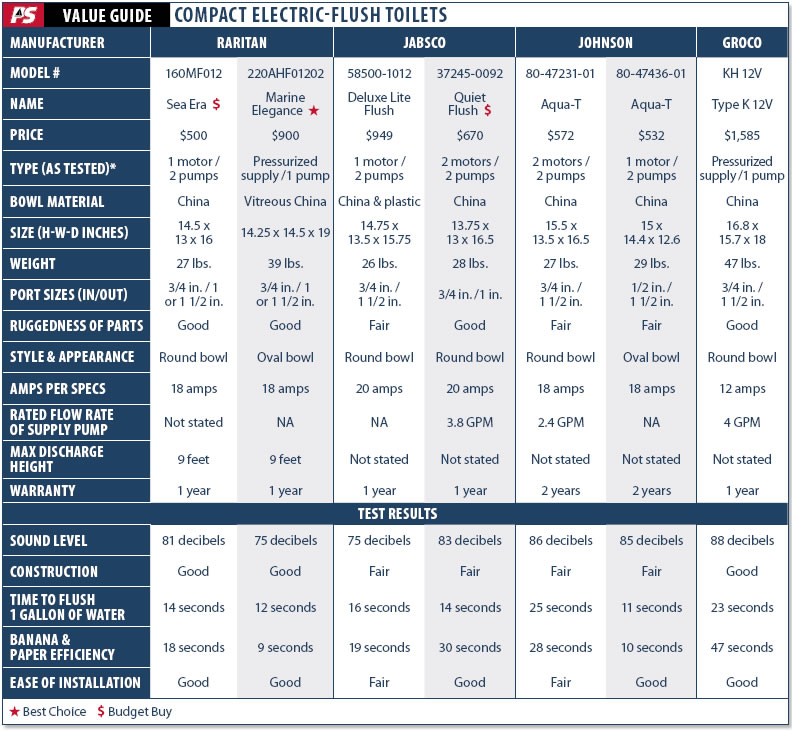
While sailing purists may shudder, more and more sailboats are eschewing the old, familiar piston-pump, manual flush toilets in favor of deluxe electric-flush models. Yes, Jack Tar has come a long way from using the openings over the bow of a sailing ship—the origin of the word “head”—or the old cedar bucket. The modern toilet is a push-button affair, and this significant shift in technology brings with it advantages and disadvantages.
Until this year, Practical Sailor’s marine toilet tests have focused on the manual varieties. PS testers compared manual-pump heads in the September 2000 issue, compact portable heads in the September 2002 and October 2005 issues, and two of the leading manual heads (Raritan and Jabsco) in the January 2008 issue. These two units are both doing well in their “head-to-head” field trials aboard a Beneteau First 435.
Most sailors are intimately familiar with manual-pump toilets that have long been the standard on sailboats. Some of these old standbys are still around, but many have been significantly upgraded, or are no longer being manufactured. These days, long-time favorites like the iconic bronze Wilcox-Crittenden Skipper (the old one-armed bandit) have been replaced by lighter, smaller models that cost less than the basic repair kit for the Skipper. We plan to do an update on manual toilets by this summer, but this article focuses electric flush toilets. Once considered a frivolous luxury for larger sailboats and motoryachts, the new breed of electric heads are generally more compact, more reliable, and less expensive than their predecessors.
Manufacturers are offering multiple models and options for both the marine and RV markets. For boats currently fitted with manual heads, an upgrade is not beyond the capabilities of a competent do-it-yourselfer.
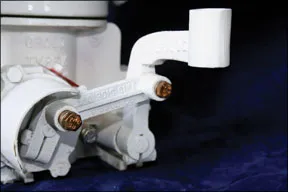
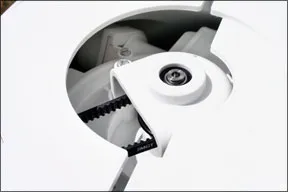
Electric toilets have another advantage: The automatic electric macerating pumps do a better job of efficiently eliminating waste, especially for the landlubbers and guests who don’t know whether they should pump once, twice, or 16 times.
Any toilet upgrade must take into account plumbing details, but a conversion to electric also entails additional power requirements, wiring details, and over-current protection. Operating for only a few seconds per flush, the electric-pump toilets reviewed here will not add a great deal to the daily amp-hour loads of a cruising boat. However, the momentary loads of the electric pumps and macerators can be as high as 30 amps, a demand-surge that can have consequences if the house battery bank is low or the electrical system is not designed to accept such loads. There is more than a grain of truth to the sea yarn about the autopilot that took a sharp turn to port every time someone flushed the toilet.
Make sure you have ample battery banks to add the pump motors to your system and that the installation uses adequately sized wiring and overcurrent protection in the form of fuses and/or breakers. Use of an inline seawater strainer is recommended to keep out algae, seaweed, organisms, and other material that could clog raw-water pumps and cause unwanted odors. Many of the odors associated with holding tanks come from decaying organisms introduced through the raw-water intake.
The pump motors and switches do not add a great deal of complexity to the system, but these parts are generally not user-serviceable, so owners of manual heads contemplating an upgrade should figure the cost of a spare pump into the equation. Owners of boats with two heads may want to keep a manually operated head in case of electrical failure, and self-sufficient voyagers may be best served by a manual head, which sells for about half the price of the least-expensive electric version.
Ideal plumbing systems will vary greatly among boats, and this article will not delve into the details of a complete marine sanitation system or the pros and cons of various options. Most of the manufacturers of the products tested here offer selection and installation guides, although some are much better than others. Two good resources for do-it-yourselfers contemplating an upgrade are Nigel Calder’s “Boatowner’s Mechanical and Electrical Manual: How to Maintain, Repair, and Improve Your Boat’s Essential Systems,” and Peggy Hall’s “Get Rid of Boat Odors: A Boat Owner’s Guide to Marine Sanitation Systems and Other Sources of Aggravation and Odor.”
When installing a new toilet, follow the instructions carefully as to wire size and discharge sanitation hose size and length. Most boats will have a ¾-inch through-hull seacock valve as the inlet for raw-water flushing. For the outlet, a 1½-inch outflow hose will usually lead to a lockable Y-valve that diverts flow to either a holding tank or directly overboard through a seacock. (The Y-valve must be locked or sealed in sensitive areas designated as No-discharge Zones.)
Offshore cruising boats may also have to add plumbing and pumps to clear their holding tanks out beyond the three-mile limit. Discharge of untreated waste is not permitted in the coastal or inland waters of most countries, including the United States. Raritan Engineering makes a range of Type I Marine Sanitation Devices that treat waste for overboard pumpout in coastal areas where discharge of treated waste is permitted.
Some systems can be used with pressurized fresh water, and some bigger boats may have sufficient freshwater capacity to use the pressurized water intake models. Patient instruction to all new hands, and prominently posting stickers covering the proper use of the head can help reduce the need for unscheduled maintenance.
Every skipper will face a clogged head in his lifetime. A good one will work to resolve the problem rather than ranting, cursing, and trying to pass the blame.
What We Tested
There are dozens of different models of electric toilets depending on size, weight, style, voltage, color, function, and features. Several models are available in different iterations. They can come with or without separate inlet water pumps, macerator pumps, solenoids, or electronic control boxes. Some come with a simple push-button or a more elaborate multi-function remote-control panel, with separate buttons for filling and flushing. Some are Spartan compacts; others are very stylish household types. Prices range from $429 to $9,999.
Practical Sailor narrowed its test to 14 toilets representing a good cross-section of the models available from major manufacturers, including Dometic, Groco, Jabsco, and Raritan. These are the types most likely found at marine chandleries in the U.S. or onboard new boats sold domestically. One test unit used a 24-volt pump, but all the others were 12-volt DC. However, pumps with other voltages are available. Some have the intake and flushing pumps separate and remotely mounted; some pumps are integral and located under the bowl; and others operate a combined inlet-flush pump. Seven units used solenoids to control pressurized fresh water. The field included heads with compact typical marine bowls and those with the larger standard-size bowls. Elongated household-type bowls, and bowls with slanted backs to fit hull shapes in the bow are also an option for some models.
In order to simplify evaluations and comparisons, PS divided the test field into two groups. Group I comprises seven sample electric toilets that are smaller, low profile, more compact, and more economical. Group II, which will be featured in the March 2011 issue, comprises the larger, taller, and more expensive household-type toilets.

Groco Type K
Gross Mechanical Laboratories has a long history of manufacturing marine- and industrial-grade pumps, valves, seacocks, and hardware including manual toilets and holding tank systems. The Type K series is a no-frills, utilitarian toilet with the oval China bowl sitting on top of an open mechanical base with all the bronze parts exposed and painted white. The Type K 12v we tested had a bronze ¾-inch inlet hose fitting, a 1½-inch bronze outlet hose fitting and just two wires for power to the discharge pump. A foot pedal provides mechanical linkage to control input from pressurized water (no solenoid needed). The motor controls a 3-inch piston pump. To convert to manual pumping, you need only to undo a single bolt. It can be purchased as a manual head and easily retrofit the electric parts later. It has a red tag with instructions to add a half-ounce of oil (provided) to the pump, but does not say how often to add oil after use. It comes with a one-page installation/instruction sheet. Operation is simple. Press the foot pedal to let water in and push a button to pump it out. All parts are heavy duty and easily accessible for service.
Bottom line: This is an old-school, heavy-duty head that will take some punishment. However, it did not do so well with our banana test. It was the noisiest of our samples and was also the most expensive.
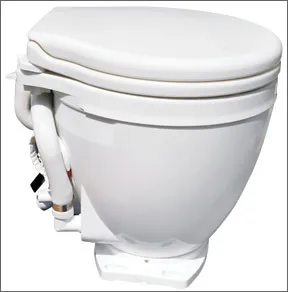
Jabsco Deluxe Lite Flush (58500-1012)
Jabsco, now part of ITT Corp., has been making marine pumps since the 1930s. The Deluxe Lite Flush is one of its newer compact toilets with interesting construction: a heavy China bowl is surrounded by plastic pieces to form a top, case, and base. It was the only test product made mostly of plastic, and gaining access to pump components and plumbing requires some patient disassembly. The plastic seat and cover is the non-slam type that slowly closes, the only of its kind in this group. The combination motor and pump is offset with a small rubber drive pulley that testers regarded as a weak link. The wiring and hose hookups were easy, although testers did experience some initial leaking. Tracing the source of the leak—a loose plastic hose clamp—required partially disassembling the plastic housing. This unit has an electronic control panel with four buttons that automatically time and control the amount of water for filling and flushing. The panel is marked “Fill,” “Quick Flush,” “Flush,” and “Empty.” The quick flush mode uses only about a cup of water, and presumably is to be used only for flushing urine. The regular flush mode uses about a half-gallon and flushes twice. The noise and speed during flushes were average.
Bottom line: The Deluxe Lite Flush was clearly the most unique product in this field, but none of its novel features outweighed testers’ concerns about access to plumbing and durability in a rigorous marine environment.

Jabsco Quiet Flush (37245-0092)
This compact model has an open base to expose the hose fittings and discharge pump (the pump has a white snap-on cover). The self-priming remote intake pump has a plastic replaceable pump mount and replaceable insert bushings. It comes with a 6-foot wire cable for the remotely mounted control panel, but testers found the electric wiring diagram in a loose eight-page instruction booklet to be confusing. The buttons are marked “Flush,” “Fill,” and “Empty.” The inlet hose is ¾-inch and discharge is 1-inch. The Quiet Flush’s performance was Good, but its noise level was middle of the pack and the flushing action was a little slow.
Bottom line: The Quiet Flush performed well, although not quite living up to its “quiet” billing, reaching an average of 83 decibels during flushes. Its instructional support lagged behind the Raritan Sea Era, but its competitive pricing earned it a tie with the Sea Era for Budget Buy.

Johnson Pump Aqua-T (80-47231-01)
Johnson Pumps is part of the Swedish SPX Flow Technology Corp., which has 75 years of experience providing pumps and liquid transport systems. The company’s toilets come with a two-year warranty, compared with the one-year warranty for other products in this test. The intake water pump—rated for 2.4 gallons per minute—seemed anemic compared to others in this test. It took longer than others to fill the bowl and longer to evacuate. It was also a little noisier (86 decibels, about 25 decibels louder than normal conversation), despite the permanent rubber feet on the pump motor. The stamped metal mount used spot welding, a common failure point on similar components when exposed to a marine environment. Testers found the long instruction sheet to be somewhat confusing. The lightweight, round, compact ceramic bowl and wooden seat and cover are very similar to the Jabsco Quiet Flush, as is the switch. It comes with a 4-foot cable for the remote rocker switch for “Fill” or “Flush.” Both Johnson test toilets are relatively inexpensive.
Bottom line: Although testers had no major complaints about this unit, both the Raritan Sea Era and the Jabsco Quiet Flush performed better in tests and scored higher points for features and construction quality.
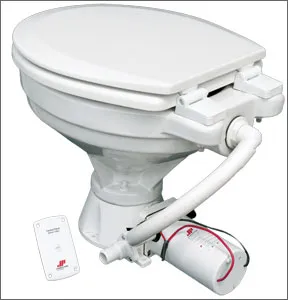
Johnson Pump Aqua-T (80-47436-01)
This is the “comfort” model, and unlike the other Aqua-T we tested, it has a wooden seat and cover. Although it was one of the most compact in our test group, weighing only 29 pounds, this Aqua-T has a larger oval bowl and seat. The toilet has one motor with a well-proven, dual-diaphragm, self-priming pump. Noise was a little high, but the water intake and discharge worked faster and better than the other Johnson model in this field. It was, in fact, one of the fastest flushers overall. The remote button was distinct from its sibling’s, with a single button to control fill and flush. Both Johnson Aqua-T toilets are compact and utilitarian, with open bowl bottoms and exposed pumps.
Johnson also has a “premium” line of electric toilets with more deluxe looking one-piece bowls.
Bottom line: Of the two Johnson models we tested, this one stood out. Pricing was competitive, the seat was among the most comfortable, and the two-year warranty is better than any other pump in this test. This Aqua-T is a close competitor with the Jabsco Quiet Flush, but not as impressive as the Raritan Sea Era.
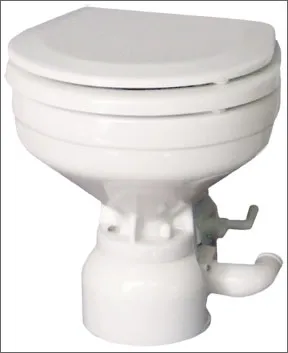
Raritan Sea Era (160MF012)
Raritan, a 50-year-old company, manufactures a wide line of marine toilets, sanitation devices, and freshwater systems. The Sea Era model is an inexpensive, lightweight, compact toilet with a small footprint, even with the pump attached under the bowl.
This seawater model has one integral pump for both water intake and flushing. It comes with three intake options, left, right, and straight back with the necessary plugs, straight or 90-degree fitting for a ¾-inch intake water hose. The discharge port comes with two nozzles, either a straight combo 1-1½-inch fitting or a 90-degree 1½-inch fitting. It also includes an in-line water strainer, the most rugged of the three brands testers looked at. Function is simple, with one pushbutton to operate the one motor with intake and discharge pumps. The Sea Era was a little louder than others, but in terms of water usage and time-to-flush, its performance was in the middle of the pack. It was one of the lightest-weight units with a small round bowl and seat, and was the least expensive of our test field.
Bottom line: Raritan’s long experience in the marine market is evident, even in its bottom-of-the-line products. The Sea Era lacked the flushing power of the two-motor models, but it is a good low-budget choice for those making the switch to electric. Small parts and materials were generally a cut above Jabsco and Johnson. This toilet earned a Budget Buy in this category.

0)]
Raritan Marine Elegance (220AHF01202)
This is an elegant-looking, one-piece, cream-colored heavy-duty marine toilet with a larger bowl and wood seat and cover that was set up for pressurized freshwater supply and a solenoid valve to control flow. It can be configured to operate with a separate supply pump. It is a full-size seat, but is considered a compact due to its small 12-inch footprint. All components are first-class, tucked nicely under the bowl, and the discharge motor is coated to resist corrosion.
Function is also simple since it comes with the same single remote pushbutton as the Sea Era. Hookup and installation was easy, and the function was fast and efficient and quieter than most. It did leave a few inches of clean water in the bowl after flushing, but this should not be a problem.
Bottom line: Larger and heavier than the others in this field, the Raritan Marine Elegance is a good compromise for someone who wants the comforts of a home toilet, but is limited by space. An excellent choice for those who can spare the extra money, the Marine Elegance was the Practical Sailor Best Choice in this group.
What We Found
Most manufacturers offer multiple models, and each model can be ordered with multiple options and features. Most electric toilets are designed for the RV market or the higher-end marine market. It was obvious that marketing and sales efforts are being directed to boat manufacturers, not retrofit end users. However, you can choose various styles, sizes, voltages, water intakes (pressurized water or raw-water pumps), and many different electronic controls. We probably could have tested 14 different toilets from each manufacturer.
Activation can be a simple pushbutton or multiple buttons to give timed functions for amount of water, length or number of flushes, and how much water to leave in the bowl. Automation might be an advantage in some situations, but basic manual controls to fill, flush, and empty the bowl, are all most users will need.
Some of the better functioning toilets were also the loudest. Noise comes from two sources: The discharge motor and pump (depending on whether it is tucked under the porcelain housing)and the suction noise of water leaving the bowl. The suction noise in some test toilets were continuous, and others just had a quick cough at the end.
Better efficiency is determined by two functions: The amount, pressure, and swirl in the bowl of the intake water, and the speed and efficiency of the discharge pump. Those samples hooked up to pressurized fresh water had a little advantage with the 48 PSI pressure to fill and swirl the bowl, and the actual engineered design of the outlet hole in some bowls allowed the material to be swished away faster.
There are reasons your household toilet has water in the bowl at all times. It is much easier to swish solid material down if it is in water. In addition, there is a reason that the attached water tank, or water closet (WC), as it used to be called, has at least a gallon of water to flush, with gravity.
Presumably, we could use standard household toilets on board if you add a WC and could tolerate water sloshing out of the tank and bowl in pounding seas, heavy weather, or when heeling. (Fun!) Our better functioning marine toilets provided ample water either through good intake pumps or pressurized intake water. The best seemed to have controls to allow a “fill only” function before flushing to better imitate a household toilet.
To eliminate the chance of holding tank odor, some designs opted for leaving a little water in the bowl (but it could spill in lumpy seas or excessive heeling) or left water in an “S” curved pipe (like under your sinks). Others (including many manual heads) include the infamous joker valve, a rubberized flexible valve that allows discharge in one direction only, and pinches off the backflow of waste and odor.
Most of the compact units looked more traditional and were probably adapted from their manual pump cousins. (Look for a Practical Sailor update on Manual Marine Toilets by early summer.) The more modern style with one-piece China bowls may be more expensive, but they seem to be quieter and easier to clean and keep clean. We definitely will see more of them.
Conclusions
Over the course of two weeks, PS testers looked at 14 electric marine toilets from seven different manufacturers. The choices ranged from compact utilitarian heads to very stylish, heavy thrones. While the latter units presented some NASA-worthy installation challenges, putting in any of the seven toilets in this report is within reach for the do-it-yourselfer.
In some cases, you could save money by fitting your existing toilet to the new electric pump base. An exception would be the Raritan Marine Elegance, which has a different footprint.
Overall, testers were impressed with the performance of these units. None of the pumps and macerators failed the flushing tests, but some were clearly more efficient.
If you are looking for the least-expensive entry into the field of electric toilets, three units stand out: (in order of ranking) the Raritan Sea Era, the Jabsco Quiet Flush, and the Johnson Aqua-T (80-47436). The chief differences in the three boiled down to ruggedness of individual components and ease of installation.
If you’re looking for the best compact unit on the market, and aren’t too concerned about the expense, the Raritan Marine Elegance was clearly the Best Choice. Its modern style, excellent construction and rugged components set it apart. It also proved to be the most efficient flusher, fast and requiring very little water.

1)]
Look for a review of top-of-the line residential style toilets in next month’s issue of Practical Sailor.
